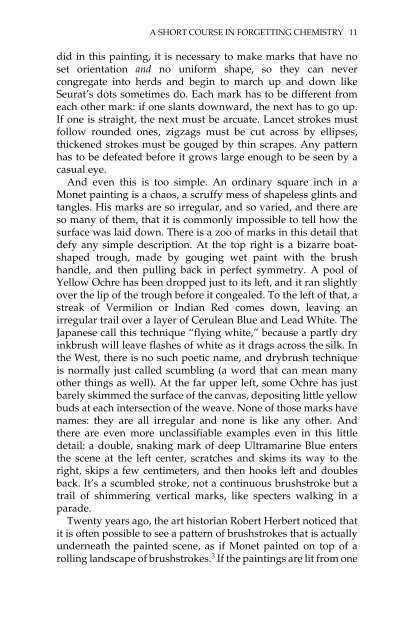What Painting Is: How to Think about Oil Painting ... - Victoria Vesna
What Painting Is: How to Think about Oil Painting ... - Victoria Vesna
What Painting Is: How to Think about Oil Painting ... - Victoria Vesna
You also want an ePaper? Increase the reach of your titles
YUMPU automatically turns print PDFs into web optimized ePapers that Google loves.
A SHORT COURSE IN FORGETTING CHEMISTRY 11<br />
did in this painting, it is necessary <strong>to</strong> make marks that have no<br />
set orientation and no uniform shape, so they can never<br />
congregate in<strong>to</strong> herds and begin <strong>to</strong> march up and down like<br />
Seurat’s dots sometimes do. Each mark has <strong>to</strong> be different from<br />
each other mark: if one slants downward, the next has <strong>to</strong> go up.<br />
If one is straight, the next must be arcuate. Lancet strokes must<br />
follow rounded ones, zigzags must be cut across by ellipses,<br />
thickened strokes must be gouged by thin scrapes. Any pattern<br />
has <strong>to</strong> be defeated before it grows large enough <strong>to</strong> be seen by a<br />
casual eye.<br />
And even this is <strong>to</strong>o simple. An ordinary square inch in a<br />
Monet painting is a chaos, a scruffy mess of shapeless glints and<br />
tangles. His marks are so irregular, and so varied, and there are<br />
so many of them, that it is commonly impossible <strong>to</strong> tell how the<br />
surface was laid down. There is a zoo of marks in this detail that<br />
defy any simple description. At the <strong>to</strong>p right is a bizarre boatshaped<br />
trough, made by gouging wet paint with the brush<br />
handle, and then pulling back in perfect symmetry. A pool of<br />
Yellow Ochre has been dropped just <strong>to</strong> its left, and it ran slightly<br />
over the lip of the trough before it congealed. To the left of that, a<br />
streak of Vermilion or Indian Red comes down, leaving an<br />
irregular trail over a layer of Cerulean Blue and Lead White. The<br />
Japanese call this technique “flying white,” because a partly dry<br />
inkbrush will leave flashes of white as it drags across the silk. In<br />
the West, there is no such poetic name, and drybrush technique<br />
is normally just called scumbling (a word that can mean many<br />
other things as well). At the far upper left, some Ochre has just<br />
barely skimmed the surface of the canvas, depositing little yellow<br />
buds at each intersection of the weave. None of those marks have<br />
names: they are all irregular and none is like any other. And<br />
there are even more unclassifiable examples even in this little<br />
detail: a double, snaking mark of deep Ultramarine Blue enters<br />
the scene at the left center, scratches and skims its way <strong>to</strong> the<br />
right, skips a few centimeters, and then hooks left and doubles<br />
back. It’s a scumbled stroke, not a continuous brushstroke but a<br />
trail of shimmering vertical marks, like specters walking in a<br />
parade.<br />
Twenty years ago, the art his<strong>to</strong>rian Robert Herbert noticed that<br />
it is often possible <strong>to</strong> see a pattern of brushstrokes that is actually<br />
underneath the painted scene, as if Monet painted on <strong>to</strong>p of a<br />
rolling landscape of brushstrokes. 3 If the paintings are lit from one


